Events and excursions, Spring 2010
THE MAURICE BARLEY LECTURE, 13 FEBRUARY 2010
Laxton: the contemporary significance by Hugh Matheson
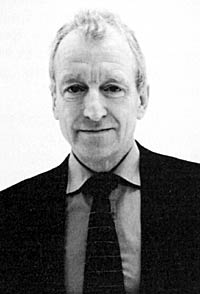
Hugh Matheson, by his own admission, was at odds with the centuries old law of primogeniture, the right of the eldest son to succeed to the estates of ancestors. In 1976 as the youngest child, of the youngest child, of the youngest child of the 3rd Lord Manvers, he came into the Nottinghamshire estates of the Pierrepont family, which still include part of the village of Laxton.
The Pierreponts had owned the freehold of Laxton from 1640 to 1952 when much of it was sold to the Ministry of Agriculture for £50,000 by the 6th Earl Manvers. Sometime after 1979, when the Conservative Government decided to sell Laxton along with other state assets, a campaign was launched to save the village which was only partially successful. It was eventually purchased by the Crown Estates Commissioner for £1 million, the stipulation to maintain the open field system of farming halving its anticipated market value.
Although there had been partial enclosure in the past, Laxton preserves the last of the former widespread open field system. Some 480 acres in the parish are divided between the West, Moll and South fields, within which are just over 160 strips There are 14 full time farmers, although the worry about succession, the drift of the younger generation away from the village, is never far away.
After giving a brief history of the survival of these 'strips' Hugh focussed on maintaining them for the future. The villagers see themselves as a thriving working community not to be considered as an historical tableau or animated theme park.
Whilst their individual produce would be subject to the supply and demand, and therefore unfavourable pricing, on the global market; collectively the farmers could take advantage of the current trend to 'buy locally'. There is a potential market for the Laxton farmers to cater for those against mass production and the creeping monopoly of the supermarkets, as shown by the success of existing 'farm' outlets across the country. What is needed is investment to set up a sizeable farm shop, a financial commitment that the Crown Estates have so far avoided. Laxton is perfectly placed to develop rare breeds and reintroduce forgotten types of fruit and vegetables, which could make their retail outlet unique. Whilst at the moment there is little specialism amongst the farmers, Hugh pointed out that there was scope for initiative in this area.
As the local farmers are not under any direct threat the possibility of attracting interest from the National Trust cannot be contemplated. Royal intervention was not particularly helpful.
Hugh managed to hold the interest of a large audience without the use of any visual aids, the first such achievement at a Thoroton meeting for some time!
Ken Brand
LAXTON
If you attended our lecture on 13 February , you will have heard a stirring assessment of the current position at Laxton, given by Hugh Matheson. Since it was a difficult lecture to summarise, we have had the whole text mounted on the Society's website. If you would like to read it again, or if you were unable to attend the lecture and would like the opportunity to read for yourself Hugh Matheson's ideas on how Laxton might be conserved into the future, do go on to the website and read it through. Hugh was hard hitting, to say the least, and as a society we have agreed to give him what support we can.
John Beckett
THE MYLES THOROTON HILDYARD LECTURE, 13 MARCH 2010
The longcase clock, 1675-1900 by Alan Midleton
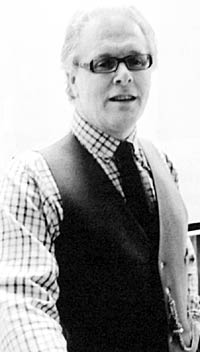
This was the last in the 2009-10 winter lecture series, and it is linked to a related summer excursion to the British Horological Institute at Upton on Thursday 9 September 2010, when Alan Midleton will be in attendance!
Although the earliest mechanical clocks date from the 13th century, the infusion of Huguenot skills in the later 16th century led to a significant improvement in clock making in England. The longcase clock, perhaps better known colloquially as the 'Grandfather Clock' - annoyingly the term turns out to have been invented by an American whilst visiting Yorkshire - dates from the 1670s.
Alan's lecture covered cases, winding mechanism, time keeping, sizes, styles, decorations, regional varieties, accuracy, and winding times - from daily to thirty hours, to eight day clocks. He also commented on the fact that many of the clocks were assembled from parts made by different firms - the winding mechanism, the case, and so on.
Penny Messenger and Margaret Trueman will lead the excursion, and the one thing you can afford to forget is your watch!
Alan was, for eleven years until 2006, the horological expert on the Antiques Roadshow, which is why his face seemed familiar to many in the audience.
John Beckett
AGM 2010

Professor John Beckett, Steph Mastoris and Adrian Henstock.
We were really fortunate, yet again, to have such a lovely Spring day for our visit to Bingham for the 2010 AGM on 24 April. Our well attended meeting was held in the Methodist Church Hall which proved to be a most convenient and pleasant venue: we are grateful to Valerie and Adrian Henstock for making all the arrangements for us. Adrian, in his role as a Vice-President of the Society, stood in for our President, Rosalys Coope, who was recovering from an operation, in welcoming us to Bingham. Adrian also gave an outline of the Bingham Heritage Trails Association (BHTA) and its projects and the presentations which were to be given after the formal meeting was finished.
As usual, our Chairman, Professor John Beckett, conducted the business of the meeting with his customary dispatch: the annual report and accounts were accepted and a small increase in the annual subscription for Ordinary members of £2 was agreed, bringing it up to £24.00: officers and members of Council were elected.
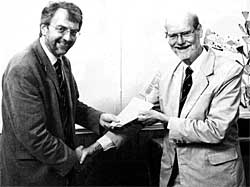
Leslie Cram is thanked for his work as Programme Secretary on the occasion of his retirement from the post.
The Chairman in his report, thanked officers of the Society for all their hard work over the year, especially Leslie Cram who had stepped down from the role of Hon. Programme secretary and Leslie was presented with a book token. He also congratulated Howard Fisher on his colourful development of the Newsletter since he had taken on the editorship and the Transaction Editors, Richard Gaunt and Keith Challis, for another excellent volume. Professor Beckett then updated members on the events of the year: the new lecture dedicated to former President Neville Hoskins, generously endowed by a donation from his family: the imminent publication in the Record Series of the Gedling Town Book. Steph Mastoris also updated us on the forthcoming Welbeck Estate Maps volume with its 78 maps being digitised thanks to Eric Coddington's grant, and hopefully going to print by the early Autumn.
The Chairman was also pleased to report progress with his other hat on, that of the Victoria County History - a number of East Midlands Counties, including Nottinghamshire, had begun to move forward on county histories, in Notts' case after work had lain dormant since the First World War! He had also arranged a meeting of representatives of the County History and Archaeological Societies such as Thoroton which is reported upon elsewhere in this Newsletter. Finally John mentioned the sad loss of a number of members this year, including one of our Vice-Presidents and former Programme Secretary, Maurice Caplan.
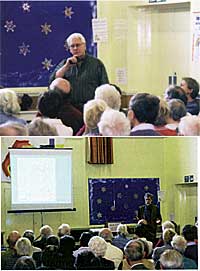
The speakers from the Bingham Heritage Trails Association, Geoff Ashton and Peter Allen.
After the AGM was over we were given presentations by Peter Allen, the Chairman of BHTA, and Geoff Ashton, on the projects undertaken by the BHTA. With Lottery funding support they have completed field-walking the whole of Bingham Parish's undeveloped land, noting all finds identified by Trent and Peak Archaeology, and also those frustrating places where there were no finds - it took 100 volunteers three winter seasons to walk all the C2000 acres.
They have also reconstructed a map of the town centre and open fields as they were in the 16th century, based on a written survey of 1586, and a book is at the printers entitled Bingham Back in Time.
There followed another superb AGM tea - each year seems to surpass the last! Thanks to the ladies and gentlemen of the Methodist Church for this.
After tea, three parties made their way around Bingham - what a lot of history is tucked away in its back streets. We all ended up at the church at the same time - good planning or what? - where the Rector, David Harper, told us about the church and some of its famous and interesting incumbents together with other associated characters.
As is usual for our AGMs, all those who attended had an enjoyable and fascinating visit to one of the smaller Nottinghamshire towns - many thanks to all those involved in making it a great day.
Barbara Cast (Hon. Secretary).
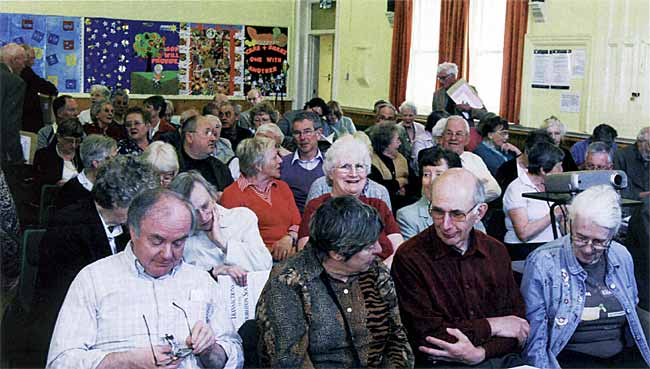
The audience.